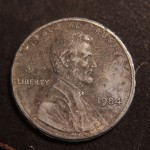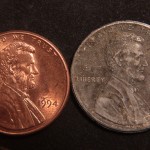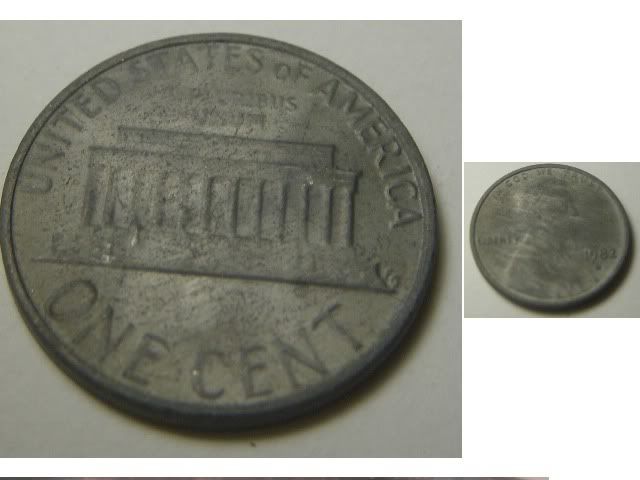I FOUND A 1987 D US PENNY,DARK GRAY IN COLOR,WEIGHT IS 2.26 IN GRAMS.JUST WONDERING IF IT IS A ZINC WEIGHT OR ALUMINUM WEIGHT.
1987 D US PENNY. DARK GRAY IN COLOR,WEIGHT 2.26 GRAMS.
Collapse
X
-
Welcome to the forum Capt!! No aluminum 87D's I'm aware of. It's probably just damage of some sort, like stripped by acid. We would need to see it to really have some idea though. Can you get a pic up?
I used to live in Bluefield, not to far from you.Last edited by makecents; 04-14-2019, 04:14 PM. -
Welcome to the forum. Pictures will be helpful, but enamel7 is most likely correct. Check to see if the diameter is slightly larger than normal.All opinions expressed are not necessarily shared by willbrooks or his affiliates. Taking them may result in serious side effects. Results may vary. Offer not valid in New Jersey.Comment
-
Comment
-
Cents that have been stripped of their plating are often lager in diameter. Don't you people read my work?
Texas Cent: A cent with a larger-than-normal diameter that was intentionally damaged outside the mint. The traditional method is hammering the cent between pieces of (usually) leather. However, another instance of cents with larger-than-normal diameters is now commonly seen on cents that have had their plating removed. Whatever methods are being used to strip the plating, most of which involve exposure to chemicals and heat, are leaving the resulting zinc core thinner with an expanded diameter. I am still trying to investigate exactly how this is happening. Below is an example of one of these stripped cents. Photos courtesy of jallengomez.

 All opinions expressed are not necessarily shared by willbrooks or his affiliates. Taking them may result in serious side effects. Results may vary. Offer not valid in New Jersey.
All opinions expressed are not necessarily shared by willbrooks or his affiliates. Taking them may result in serious side effects. Results may vary. Offer not valid in New Jersey.Comment
-
LOLCents that have been stripped of their plating are often lager in diameter. Don't you people read my work?
Texas Cent: A cent with a larger-than-normal diameter that was intentionally damaged outside the mint. The traditional method is hammering the cent between pieces of (usually) leather. However, another instance of cents with larger-than-normal diameters is now commonly seen on cents that have had their plating removed. Whatever methods are being used to strip the plating, most of which involve exposure to chemicals and heat, are leaving the resulting zinc core thinner with an expanded diameter. I am still trying to investigate exactly how this is happening. Below is an example of one of these stripped cents. Photos courtesy of jallengomez.


Could it be part of the sacrificial nature of zinc and oxidation? similar to steel getting larger as it oxidizes and turns to rust.
EDIT: Which reminds me about another question regarding zinc. Because of it's chemical properties, can zinc still oxidize and be reduced in volume (like a boat motor anode) even if completely encased in copper? Meaning no punctures, splits or holes at all for oxygen to gain access to the zinc.Last edited by Petespockets55; 04-15-2019, 05:45 AM.Comment
-
Comment
-
It's probably missing plating from something after it was minted.
There are real cents that are missing plating from the mint and there are ones stripped using acid that takes copper off but leaves zinc intact. In either case they look pretty much undamaged but no plating and only a TPG or expert can say if it was stripped or it was not plated when struck (has flow lines, no trace of plating etc).
I think the Texas cent thing is pretty much an urban myth.
The terminology is "everything is bigger in Texas" but if you can beat a coin in leather and get the plating off and still have details, I will be surprised and if it works, it is probably true for very few un-plated cents. Nobody is beating the plating off and leaving them around for fun, it might have been done for a few cents by someone but it is not the right explanation for anything I've ever seen posted on any forum.
In Arizona, I walk a lot, I find zinc cents all the time. Some are normal, some are rotten, holes and hunks out of the zinc with copper remaining, those are in grass or places with water.
In dry sandy places I find zinc cents that sit on the sandy surface. Off the beaten path so they sit for a decade in the 100-120 summer sun. They might get some dew but not constant moisture to rot them. They have no plating, they are regular or bigger than normal diameter and the extreme ones are concave. The zinc is fine, the copper is gone. It is something natural that happens in the right conditions, the right temp and soil or sand. Sure there are a few intentional ones stripped but there are tons of natural ones and almost everything people post are natural ones. They were probably found by metal detectors and spent just like the ones I detect or see on the surface, they are beat up looking because they were in sand, walked on, drove over before being found.
I had a pile of them but spent most of them but I kept a few great examples. If someone can update the glossary with the "natural effect" I'd be happy to send them in.
The "Texas Cent" thing is really unlikely for most of them that are posted. In this order, they are:
1) Natural plating dissolved from environment.
2) Removed plating by acid.
3) No plating from the mint.
4) A Texas Cent where it was beaten off (assuming this was ever done)
This is a stripped one, a science project. Notice it is not damaged or bigger. It has traces of copper. Also it is 1982, the year zinc started so science teachers wanted to show that they were zinc but notice that it's perfect other than stripped of plating. The beat up ones are likely to be natural from the sand or soil.

Comment
-
The zinc can still oxidize after plating if it was contaminated prior to the plating being applied... That is why we can see plated frankenzincs with linear blisters and the dots all over!!!LOL
Could it be part of the sacrificial nature of zinc and oxidation? similar to steel getting larger as it oxidizes and turns to rust.
EDIT: Which reminds me about another question regarding zinc. Because of it's chemical properties, can zinc still oxidize and be reduced in volume (like a boat motor anode) even if completely encased in copper? Meaning no punctures, splits or holes at all for oxygen to gain access to the zinc.Jim
(A.K.A. Elmer Fudd) Be verwy verwy quiet... I'm hunting coins!!! Good Hunting!!!
Be verwy verwy quiet... I'm hunting coins!!! Good Hunting!!!
Comment



Comment